In a quiet workshop in Taipei, three young women meticulously sew and iron under the watchful eye of a master dressmaker with decades of experience in creating the classic qipao.
Lin Chin-te (林錦德), 74, is among a handful of craftsmen in Taiwan who still specialize in handmaking the high-collar, figure-hugging garment which was once part of many women’s daily wardrobes.
His workshop is hung with dresses, from elaborate long embroidered red silk qipaos to shorter length versions in more wearable materials.
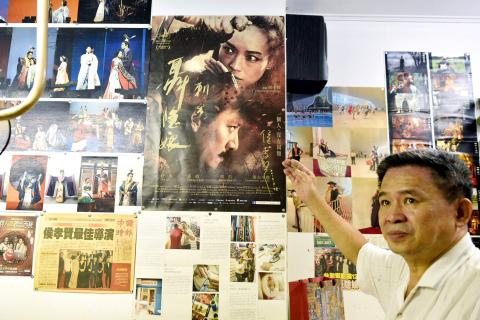
photo: AFP
Seen as increasingly impractical and pricier than off-the-peg versions, the tailormade qipao is now mostly worn at weddings and special events. Lin worries dressmakers will no longer learn his skills and takes on apprentices to pass down his know-how.
Hung Chu-tsu, 37, is one of Lin’s three 30-something female pupils.
“The master is very patient,” she says, wearing a knee-length blue floral qipao she made herself. “We start practicing from the basics and learn one stitch at a time.”
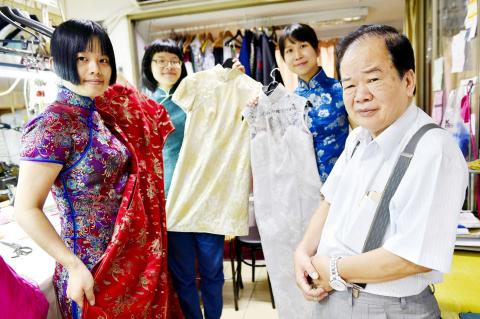
photo: AFP
Hung says she thinks qipaos are beautiful and left her career as a nurse to learn to be a dressmaker after having a child.
Her plan is to open her own shop, selling handmade qipaos adapted to a modern life. Often smiling, with braces holding up his trousers and a thimble wedged on his middle finger, Lin says he wants to ensure his 60 years of experience do not go to waste.
“I teach my pupils as much as I can and hopefully they can strike out on their own in the future,” he says.
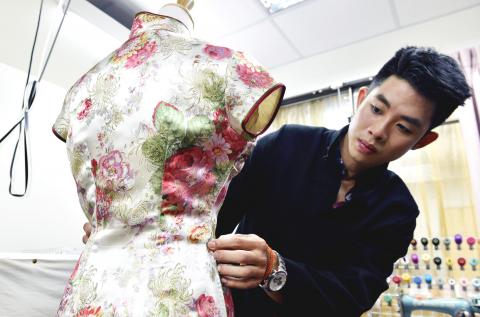
photo: AFP
“QIPAO HUNK”
The qipao — meaning “Qi robe” — began as a long, loose dress worn by the Manchus or “Qi” people who ruled China from the 17th century to the early 1900s. Its popularity took off in 1920s Shanghai when it was modified into a fitted must-have, favored by actresses and intellectuals as a symbol of femininity and refinement.
Also known as cheongsam in Cantonese, it fell out of favor in China after communist forces seized power in 1949 following the Chinese Civil War and the dress became associated with capitalism.
But the qipao gained a following in Taiwan, where defeated Chinese Nationalist Party (KMT) leader Chiang Kai-shek (將介石) set up a separate government after fleeing China. Chiang’s glamorous wife Soong Mei-ling (宋美齡) belonged to Shanghai high society and was a qipao enthusiast, influencing trends in Taiwan. Many women wore the dress daily until the 1970s.
Mass-produced, cheaper clothes eventually dented its appeal and some designers say recent growing anti-China sentiment has also put off young people as they associate the dress with that country’s culture. However, Lee Wei-fan (李威樊), 25, says there is still a fanbase. He studied qipao making under an old master for five years after deciding to carve out a niche in a field few of his design peers wanted to go into. Lee opened his own business six months ago and has built a following on social media where he goes under the name “Qipao Hunk” — something he blushes to admit was a publicity stunt.
His clients range from brides to businesswomen who see the dress as elegant. Lee says there is increasing interest in traditional Asian styles, which he hopes to tap into.
“Those of us who have a rarer craft will be more competitive,” he says.
Neither Lin nor Lee would reveal their prices but a master dressmaker charges from around US$260, not including the price of fabric.
CINEMATIC APPEAL
Arguably Taiwan’s most famous qipao maker, Chen Chung-hsin (陳忠信), 65, regularly opens up his modest workshop to tour groups and school trips to build enthusiasm for qipao making. Known for creating costumes for movies including Taiwanese director Hou Hsiao-hsien’s (侯孝賢) Cannes-winning martial arts epic The Assassin, Chen learned his skills from his father and inherited his shop. He says he makes qipaos “with a happy heart” for his clients.
“I hope that more people will see the traditional tailormade qipao is different from an off-the-peg one — mine flatters their shapes more,” says Chen. One of his loyal clients, Taipei marketing executive Yogi Ma, has set up a qipao club aimed at making the classic dress a daily wardrobe staple once more, saying it can suit any figure and can be modernized using different cuts and fabrics.
“The qipao is very elegant and pretty, it’s a pity that fewer women wear them now,” says Ma, 42, who sees it as representing the “beauty of ethnic Chinese women.”
Her Facebook-based club has over 4,000 followers and arranges events where members wear the dress to take part in activities, from whiskey tasting to flower arranging. She hopes that by promoting the dress she will help skills like Chen’s survive.
“If more people like the qipao, there won’t be an issue of lacking people to learn the craft,” she said.
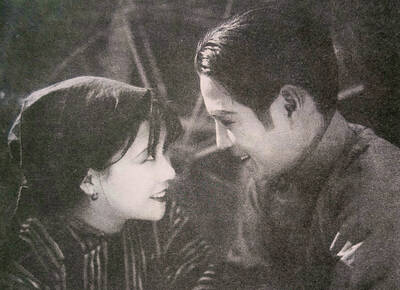
March 10 to March 16 Although it failed to become popular, March of the Black Cats (烏貓進行曲) was the first Taiwanese record to have “pop song” printed on the label. Released in March 1929 under Eagle Records, a subsidiary of the Japanese-owned Columbia Records, the Hoklo (commonly known as Taiwanese) lyrics followed the traditional seven characters per verse of Taiwanese opera, but the instrumentation was Western, performed by Eagle’s in-house orchestra. The singer was entertainer Chiu-chan (秋蟾). In fact, a cover of a Xiamen folk song by Chiu-chan released around the same time, Plum Widow Missing Her Husband (雪梅思君), enjoyed more

Last week Elbridge Colby, US President Donald Trump’s nominee for under secretary of defense for policy, a key advisory position, said in his Senate confirmation hearing that Taiwan defense spending should be 10 percent of GDP “at least something in that ballpark, really focused on their defense.” He added: “So we need to properly incentivize them.” Much commentary focused on the 10 percent figure, and rightly so. Colby is not wrong in one respect — Taiwan does need to spend more. But the steady escalation in the proportion of GDP from 3 percent to 5 percent to 10 percent that advocates

From insomniacs to party-goers, doting couples, tired paramedics and Johannesburg’s golden youth, The Pantry, a petrol station doubling as a gourmet deli, has become unmissable on the nightlife scene of South Africa’s biggest city. Open 24 hours a day, the establishment which opened three years ago is a haven for revelers looking for a midnight snack to sober up after the bars and nightclubs close at 2am or 5am. “Believe me, we see it all here,” sighs a cashier. Before the curtains open on Johannesburg’s infamous party scene, the evening gets off to a gentle start. On a Friday at around 6pm,
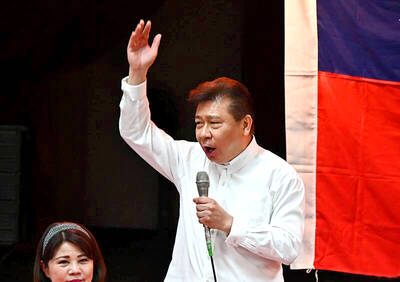
A series of dramatic news items dropped last month that shed light on Chinese Communist Party (CCP) attitudes towards three candidates for last year’s presidential election: Taiwan People’s Party (TPP) founder Ko Wen-je (柯文哲), Terry Gou (郭台銘), founder of Hon Hai Precision Industry Co (鴻海精密), also known as Foxconn Technology Group (富士康科技集團), and New Taipei City Mayor Hou You-yi (侯友宜) of the Chinese Nationalist Party (KMT). It also revealed deep blue support for Ko and Gou from inside the KMT, how they interacted with the CCP and alleged election interference involving NT$100 million (US$3.05 million) or more raised by the